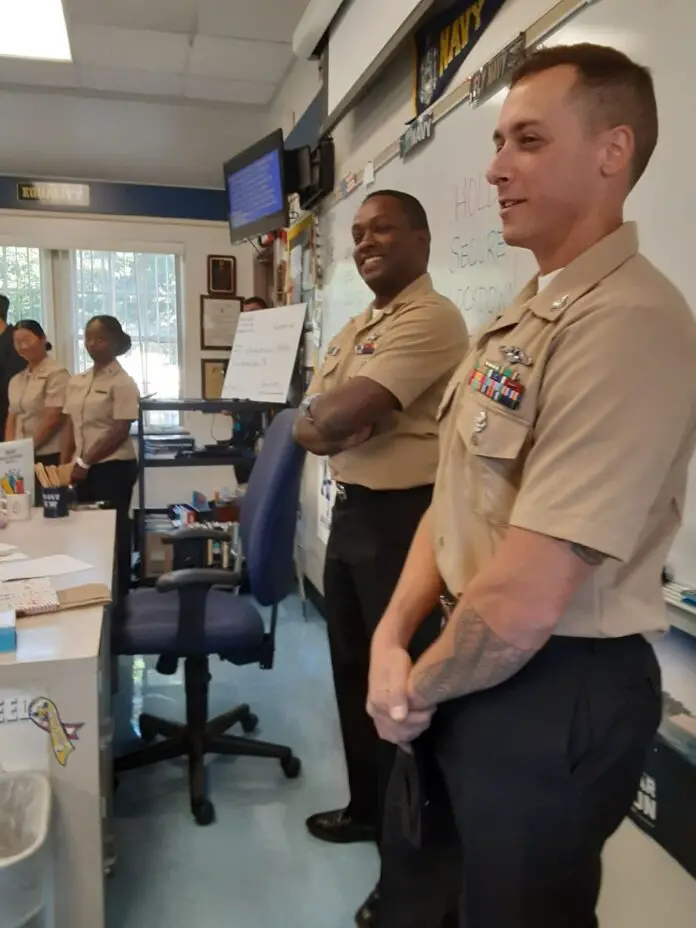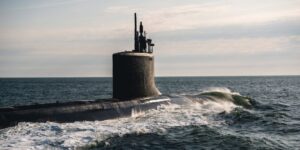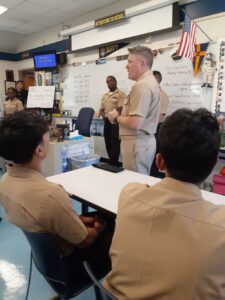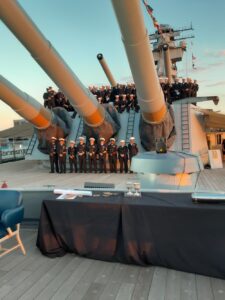Five sailors from the USS New Jersey (SSN-796) and the ship’s captain, Commander Steve Halle, spent more than an hour with NJROTC cadets at MAST, the Marine Academy of Science and Technology this week, answering questions and giving the students an idea of what life is like on a submarine.
The sailors, including two women, and three men from Puerto Rico, Brooklyn, (but raised in Texas) and Texas, explained the differences between submarines, the only Naval vessel correctly also called a boat, and other vessels in the fleet and the workload each has on a routine day.
The sailors also gave insight into their own personalities, why they joined the Navy and why they specifically chose submarine service. For each of them it was an opportunity to learn, or get a college degree, a way to serve their country, and a way to best use the specific talents they have.
Commander Halle traced the history of the US submarine force, citing the city of Elizabeth in Union County as the birthplace. Commander Halle and crew members visited Elizabeth in April 2023, and has a visit planned for this week as well.
The captain told the MAST students the USS Holland (SS1) was invented, designed, built, and launched in Elizabeth at the Electric Boat Company, a firm founded in 1899 in Elizabeth. At the time, there were competing companies, but Electric Boat, now a subsidiary of General Dynamics Corporation, was successful, and April 11 is designated as Submarine Day, the day the submarine was acquired by the US Navy.
The Holland was launched in 1897, commissioned in 1900, and served for five years before being decommissioned in 1905, stricken in 1910 and sold for scrap in 1932 after a brief time on display in Paterson, NJ.
Holland was just under 54 feet long, compared to New Jersey, which is 377 feet long, Commander Halle told the students.
Commander Halle also jokingly told the students that “like Jersey girls, submarines don’t pump gas,” detailing the system by which an atom in an onboard nuclear reactor split, releasing energy as heat. The heat is used to create high pressured steam, and it is that steam that turns propulsion turbines to provide the power to turn the propeller.
It’s the same way hot water for showers, laundry and cooking and cleaning is made, the officer responded to questions. The reactor is filled with primary water from the ocean, and that water absorbs heat that goes through the reactor and transfers the heat to a secondary unit, part of the distilling system that evaporates the salt and leaves fresh water.
It’s for this reason sailors are frugal with water, with laundry and showers the last uses after its needs for the boat, cooking and drinking. Petty Officer Second Class Christopher Baldwin explained in good humor that a shower means “get wet, shut down, soap up and scrub, rinse, shut down.” He estimated 60 seconds for a shower on board a sub.
New Jersey has one washer and one dryer, the sailors explained, with the kitchen staff having priority for cooking and cleaning. There are 130 crew members, and the sailors said sometimes they’ll combine their laundry in order to help each other.
Food is always “edible,” the sailors laughed, and varies depending on whether they are at sea or in port, with Commander Halle going into detail on how pressure in the boat and the dexterity of the chef impacts the quality of yeast breads. “There’s a trick to understanding the job of making bread on a submarine,” he noted.
There is exercise equipment even in the small quarters of a submarine, the sailors said, citing a treadmill in the engine room, a workout bench, and bar bells. The sailors cited the separate ways they choose to relax when not at work, with Baldwin saying he generally goes to his bunk to continue studying, or to read.
Electricians Mate, Nuclear First Class James Locus has been in the Navy for 12 years, and in addition to being the boat’s electronics guru, he is also one of three scuba divers on the New Jersey. “We fix what’s broken,” he explains.
Locus said he tried college, decided it was not for him, and opted for the Navy as a means of serving his country and taking on difficult feats as challenges for himself.
He cited how he chose several paths in his life, including the submarine service simply because “it was the hardest” and the most challenging for him to do. Married with two college age daughters who live in Virginia, Locus is qualified to dive to 130 feet or 190 feet with the authority of the commanding officer.
Commander Halle and the crew were hosted this week in Camden, where they had dinner and receive a tour of the USS New Jersey (BB-62), the second vessel to be named in honor of the state and the nation’s most decorated naval vessel. The battleship served in every war since World War II and is now a museum in Camden.
Leaders Leaders Leaders Leaders Leaders Leaders Leaders Leaders






